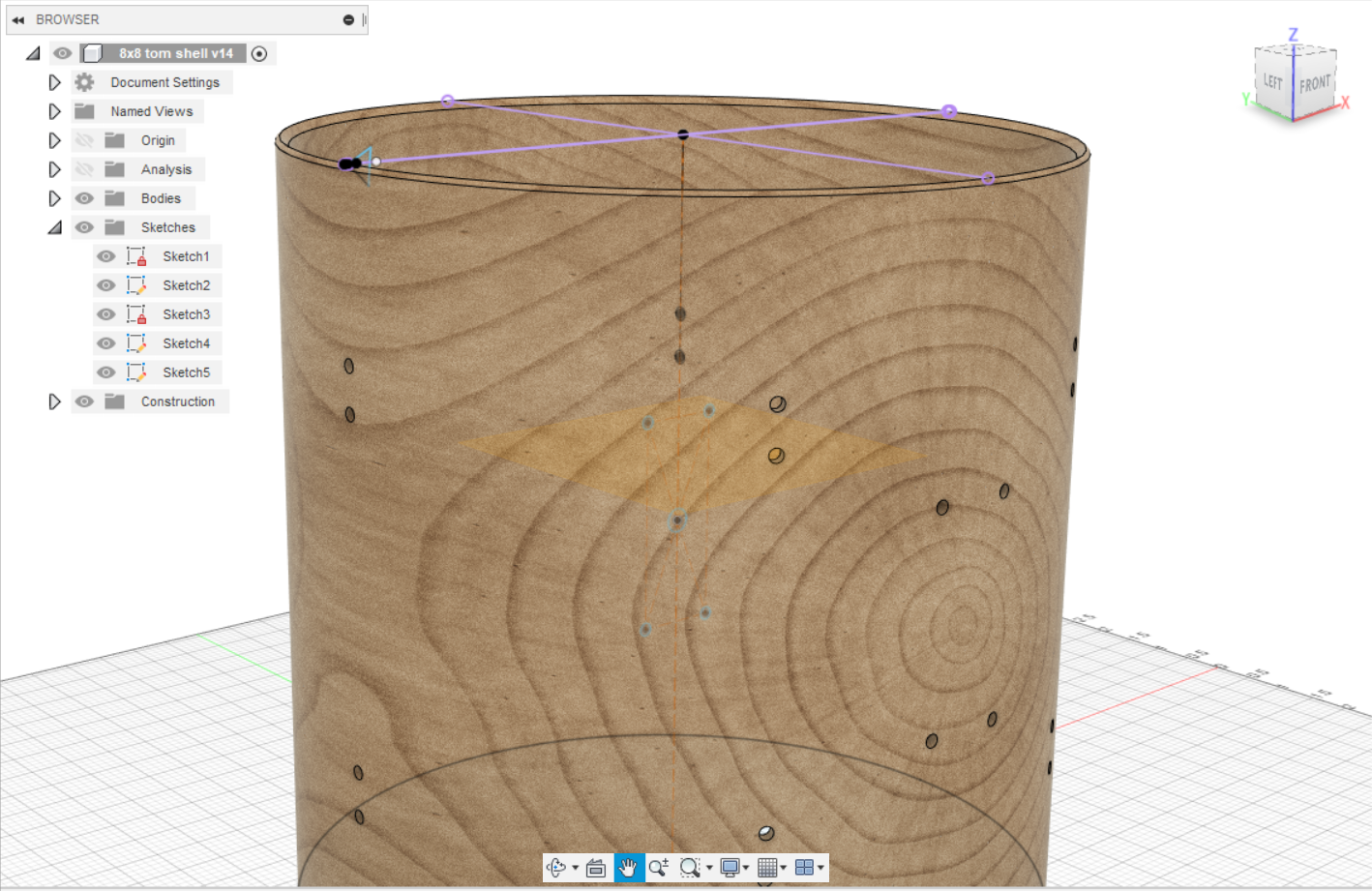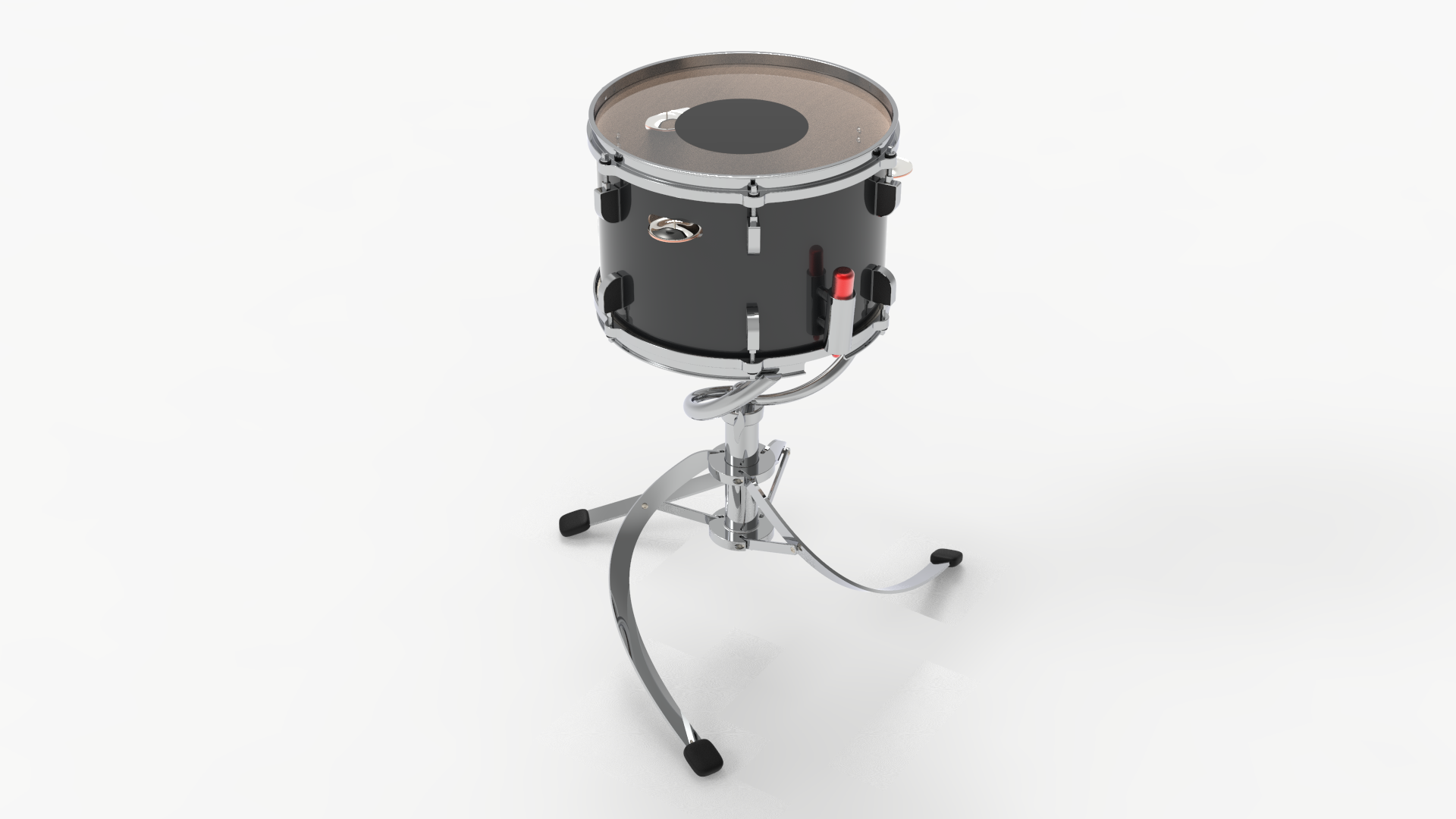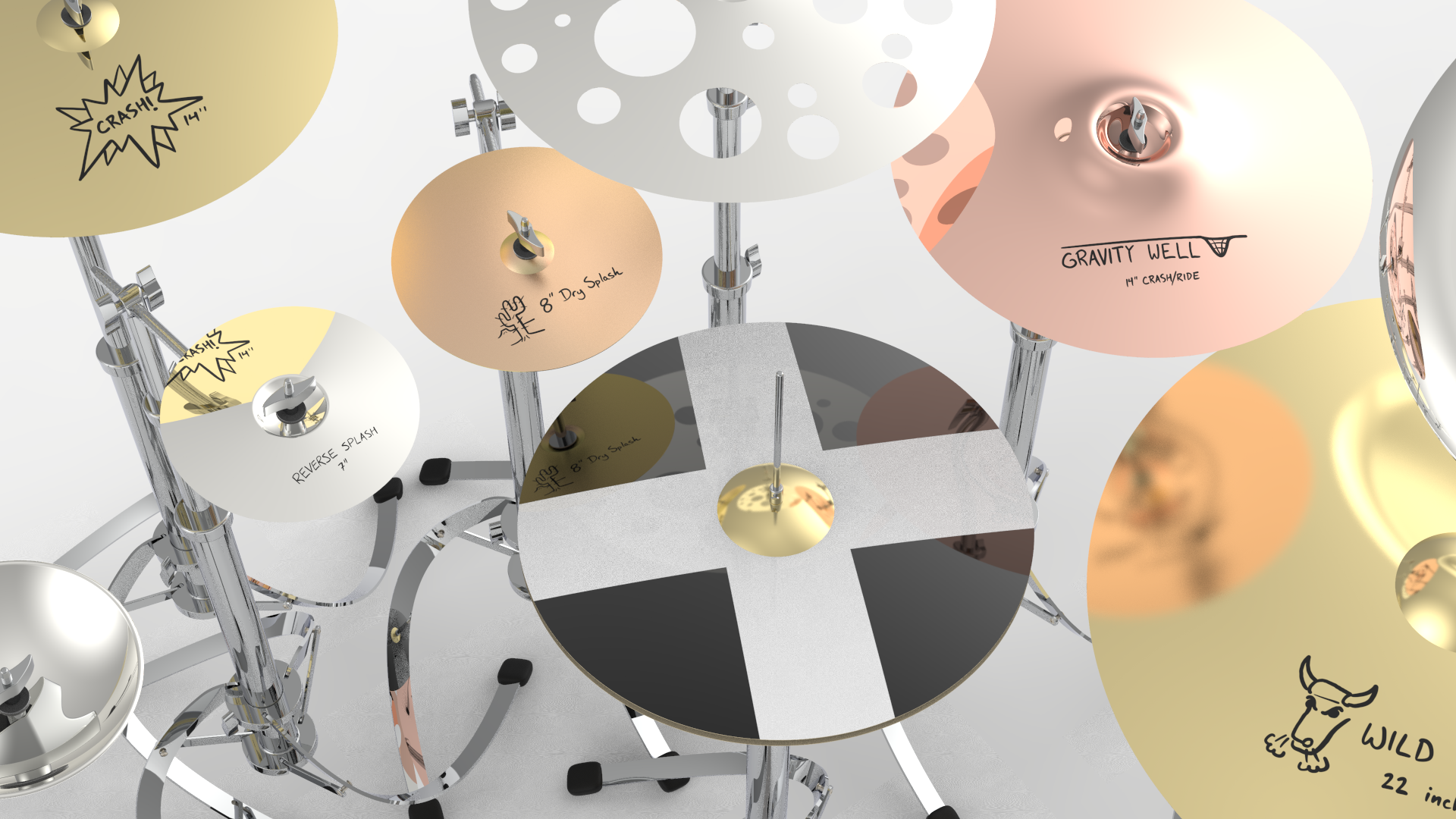My Dream Drum Set
Bringing to life percussion innovations I would like to see (and play).
Personal Project - Fall 2020
Purpose.
My mother would argue I started playing drums as a toddler, when I would drag out all the pans onto the kitchen floor and beat at them with spoons. I have been officially playing since I was in fourth grade, when I saved up all my money to buy a Dixon kid’s set. Over the years, I added cymbals and accoutrements to it, until I had amassed a massive rig.
When I moved to college, I had to sell my beloved set because it wouldn’t fit in my dorm room. I have since kept in practice using a small electric kit, but it’s not the same…
Ever since I knew I wanted to be a drummer, I have been sketching and designing my dream drum set. This project is the culmination of my engineering and design education to bring those concepts - some of which have been circling in my head for close to a decade - to life!
Inspiration.
My favorite band has long been the Police, and their drummer - Stewart Copeland - I have long endeavored to emulate. In addition to being a talented and cerebral drummer, Mr. Copeland pioneered the use of long, tubular drums called deccabons and popularized splash cymbals in rock drumming.
In fact, all the drummers I claim as inspiration have been innovators. Rush’s Neil Peart made made irregular tempos accesible to a mainstream audience. The Who’s Keith Moon built his monster kit forward, usually having two whole rows of toms between him and the audience. Karen Carpenter of Carpenters fame was playing technically accomplished solos at a a time when the drums were not considered to be a woman’s instrument. And Jughead Jones, heartbeat for the fictional band the Archies, filled his bass drum with snacks, so he would never go hungry in the middle of a performance.
Consistent timekeeping will keep a drummer employed, technical mastery will gain them fame, but only innovators go down in history as greats.
Clockwise from top left: Stewart Copeland (The Police), Neil Peart (Rush), Keith Moon (The Who), Karen Carpenter (Carpenters), and Jughead Jones (The Archies)
Ideation.
My dream drum set not only had to look good, but also allow me to play more comfortably than anything else on the market. I prefer to mount my toms (the drums above the bass drum) low, so I don’t have to reach up get to them. This affects the bass drum: a smaller diameter bass drum allows for toms to be slower but will have a weaker sound. The toms themselves are usually mounted to the bass drum; however, I wanted to give the audience the impression that my toms are floating, evoking a sense of lightness in the performance.
Additionally, I wanted a snare strainer that could be used on the fly. A snare strainer is the device that holds the snares taut to the underside of the snare drum. It can be engaged or disengaged to alter the sound of the snare drum. However, snare strainers often have clunky levers that require large radial movements to operate. I wanted something that would require a short operational movement, and ideally one that fits with the movements a drummer is naturally making.
I used good old fashioned pen and paper to sketch my ideas and iterate on the designs until I was confident in the form and function of my concept.
CAD Modeling.
Once the sketches were in a good place, I turned to Fusion 360 to bring the concepts to life.
Rather than model each drum or cymbal in its entirety as a separate file, I modeled all the pieces individually - down to the smallest screws and washers - and built everything as a series of nested assemblies.
Drums began as cylindrical surfaces which were thickened and further manipulated into the drum shells upon which all the hardware was assembled. Many of the geometries were modeled parametrically, even the fancy helix legs of the cymbals stands, though the throne seat was modeled using t-spline scultping.
Innovations.
The Bass Drum.
You may have noticed that the bass drum is not circular, but rather a wide elliptical shape. This is no accident. I designed it to be an ellipse because it makes it shorter than a normal bass drum, while retaining effectively the same volume. This allows the toms above it to be mounted lower, but it still retains a low and powerful sound. The trade-off, and there’s always a trade-off, would be manufacturing - cylinders are much easier to make.
But it caught your eye, didn’t it?.
Modeled in Fusion 360, rendered in Keyshot.
The Tom Rack.
Usually, drum racks, upon which toms and other elements are mounted, face the audience. In order to achieve the effect of the toms “floating” above the bass drum, the rack was moved inside the kit - that is, toward the drummer. Doing this also gives more real estate on the rack on which to mount other percussion elements without them fighting for space with the toms themselves. The trade-off is that now the toms are a little farther away from the drummer , but I prioritize height over distance as I find lateral movements easier than vertical ones.
Modeled in Fusion 360, rendered in Keyshot.
The Snare Strainer.
In order to maximize the efficacy of the snare strainer, I designed the mechanism to be similar to that of click pens. Pushing down the red plunger once sets the strainer to one of two stable states and disengages the snares. Pushing the plunger again moves the strainer to the other stable state, bringing the snares back into contact with the lower drum head. This simple movement is akin the motions drummers are already making anyway, and can be incorporated into the playing itself, making it easier to adjust sounds on the fly.
Though the mechanism has fewer moving parts than other strainers out on the market, it does require tighter tolerances to operate properly, and could get dirt inside the mechanism. To address this second issue, I designed the top of the plunger so that it could be unscrewed and the whole thing could be taken apart for easy cleaning. Of course, then you have to be careful not to lose the alignment bearings!
Modeled in Fusion 360, rendered in Keyshot.
The SnareCrow.
The SnareCrow is certainly unconventional. However, if you ask a drummer what’s weird about it, the first thing they will tell you is its size. Most snares have a diameter of about 14” and a depth of 4”-6”. This snare drum has a diameter of 12” and a depth of 8”. Since the diameter is small, it has a similar pitch to a regular snare, but the increased depth gives it a fuller sound.
Additionally, SnareCrow sports three tambourine jingles in elliptical cutouts. These give the snare hits a little added spice.
T. In Spring of 2020, I modified a 12”x8” tom and brought the SnareCrow to life. This involved routing holes for the tambourine jingles, cutting grooves into the drum hoops to accommodate snares, and painting the whole thing in Black 3.0 - the blackest acrylic paint in the world. Unfortunately, the holes for the jingles act as substantial vents, and they give the drum a rather stale sound quality. Additionally, the jingles only shake when the drum itself is struck, not just the plastic drum head. Lessons learned for the next iteration!
Modeled in Fusion 360, rendered in Keyshot. Fabricated using woodworking and metalworking techniques. Thanks so much to Ailene Lung for her help with the fabrication!
The Pedals.
I designed the foot pedals necessary to operate the bass drum (see above) and the hi-hat (the two black cymbals with the white ‘X’) to have just as much character as the rest of the drum set. For instance, you may have noticed that the pedals themselves are, in fact, shaped like feet. They are manufactured out of diamond-plate steel for improved grip.
The restitution force, usually provided by springs, is provided by large neodymium magnets for a smoother feel. The beater is machined from blue anodized aluminum, allowing it to be light but also pack a powerful punch.
Modeled in Fusion 360, rendered in Keyshot.
The Cymbals.
A few of the cymbals you see do not exist out on the market. One such of these is the “China Ride” - a mix between a China cymbal and a ride cymbal. This cymbal has the steady ring of the ride cymbal, but with the harsh decay of the China cymbal.
Another such cymbal is one I call the “Swiss Cheese Crash.” There are cymbals on the market that have holes cut in them. These holes create a lighter, edgier sound that decays quickly. Contrary to these other cymbals, however, the holes my cymbal sports are randomly sized an located. This imbues the cymbal with a unique sound that cuts through the mix.
Finally, my favorite cymbal innovation is the “Gravity Well Crash.” I designed this cymbal to have an inverted bell - much like a traditional China cymbal - but the inverted bell then rebounds to a normal bell. Rather than a hemisphere on which to play rhythms, the drummer is instead greeted with a half-torus. I expect this cymbal will sound… innovative.
Modeled in Fusion 360, rendered in Keyshot.
The Saturn Drum.
Ah, the unconventional yet engaging Saturn Drum. I designed it to be a truly immersive percussion experience. With this drum, the percussionist stands inside, and is surrounded by a continuous drum head. The inner and outer shell of this drum aren’t concentric, creating areas of different pitches that blend together seamlessly. The sloped cut of the shells creates continuously variable drum depths, adding to the effect.
With this drum, a drummer can perform compositions that are both rhythmic and melodic.
Modeled in Fusion 360, rendered in Keyshot.
Drum Roll Please…. The Dream Set!
Full seven-piece drum set. Modeled in Fusion 360, rendered in Keyshot.
The Drumsticks.
By now you must be thinking, “this drum set is very nice, but how will he play it?” Why, with drumsticks, of course!
I designed these drumsticks to be both comfortable and pragmatic. Double helical grooves run half the length of the shaft, providing a sure grip. The grooves themselves are shallow, so they don’t interfere with the normal way of holding the stick.
To match their intended targets, I rendered these drumsticks in the same Catalina Dream turquoise as the drums themselves,
Modeled in Fusion 360, rendered in Keyshot.
Takeaways.
This project taught me patience and pacing. Even though many of the concepts developed for this project were first envisioned years ago, the actual design and modeling still took five and a half months of working on this every day. This is, by far, the longest personal project I have worked on to date, and I feel confident managing projects over extended timelines now.
Some notable challenges were: keeping track of a massive bill of materials, learning to CAD using two hands (gotta protect those drumming wrists), and setting realistic goals.
Designing this drum set has been both a fulfilling and educational experience.






























































